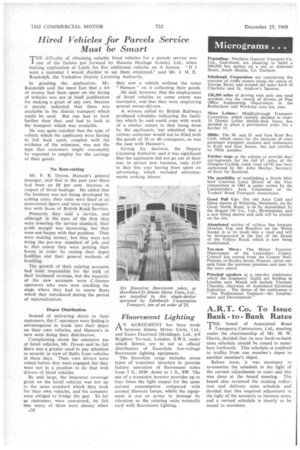Hired Vehicles for Parcels Service Must be Smart
Page 30

If you've noticed an error in this article please click here to report it so we can fix it.
THE difficulty of obtaining suitable hired vehicles for a parcels service was
one of the factors put forward by Hanson Haulage (Leeds), Ltd., when making application at Leeds for five additional vehicles on A licence. " If I were a customer I would shudder to see them employed," said Mr. J. H. E. Randolph, the Yorkshire Deputy Licensing Authority.
In granting the application, Mr. Randolph said the mere fact that a lot of money had been spent on the hiring of vehicles was not in itself justification for making a grant of any sort, because it merely indicated that there was available in the district transport which could be used. But one had to look further than that, and had to look at the transport which was available.
He was quite satisfied that the type of vehicle which the applicants were having to fall back upon, coupled with the evidence of the witnesses, was not the type that customers might reasonably be expected to employ for the carriage of their goods.
No Rate-cutting Mr. F. B. Dyson, Hanson's general manager, said that in the past year there had been an 88 per cent. increase in respect of hired haulage. He added that the business was not being developed by cutting rates; their rates were fixed at an economical figure and were very competitive with those of British Road Services,
Primarily they sold a service, and although in the .eyes of the firm they were lowering the service standard, their profit margin was increasing; but they were not happy with that position. They were making money, but they were not doing the pre-war standard of job, and to that extent they were putting their house in order by raising their depot facilities and their general methods of handling.
The growth of their existing accounts had ' been responsible for the bulk of their increased revenue, but the majority of the new accounts were C-licence operators who were now reaching -the stage where they had to renew fleets which they introduced during the period of nationalization.
Depot Distribution Instead of delivering direct to their customers, the C operators were finding it advantageous to trunk into their depot on their own vehicles, and Hanson's in turn were doing their distribution.
Complaining about the extensive use of hired vehicles, Mr. Dyson said he felt there was a greater need to pay attention to security in view of thefts from vehicles in these days. Their own drivers were vetted before they were engaged, but they were not in a position to do that with drivers of hired vehicles.
By and large, the insurance coverage given on the hired. vehicles was not up to the same standard which they took for their own vehicles, and his company were obliged to bridge the gap. So far as customers were concerned, he felt that many of them were uneasy when
A28 they saw a vehicle without the name " Hanson" on it collecting their goods.
He said, however, that the employment of hired vehicles to some extent was inevitable, and that they were employing several owner-drivers.
A witness called by British Railways produced schedules indicating the facilities which he said could cope with work of a similar nature to that being done by the applicants, but admitted that a railway container would not be filled with the goods of 30 or 40 consignees, as was the case with Hanson's.
Giving his decision, the Deputy Licensing Authority said it was significant that the applicants did not go out of their way to attract new business, only £147 to date this year having been spent on advertising, which included advertisements seeking labour.




























































































